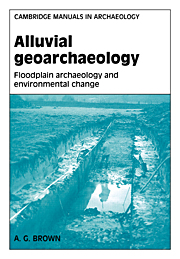Book contents
- Frontmatter
- Contents
- List of illustrations
- List of tables
- Preface
- Acknowledgements
- Introduction and the example of the Nile
- PART I PRINCIPLES
- PART II APPLICATION
- APPENDICES
- Notation
- 1 River flow and sediment transport
- 2 Flood frequency analysis
- 3 Documentary evidence and wetland perceptions
- References
- Subject Index
- Index of rivers and sites
3 - Documentary evidence and wetland perceptions
Published online by Cambridge University Press: 03 December 2009
- Frontmatter
- Contents
- List of illustrations
- List of tables
- Preface
- Acknowledgements
- Introduction and the example of the Nile
- PART I PRINCIPLES
- PART II APPLICATION
- APPENDICES
- Notation
- 1 River flow and sediment transport
- 2 Flood frequency analysis
- 3 Documentary evidence and wetland perceptions
- References
- Subject Index
- Index of rivers and sites
Summary
Place- and river-name evidence
The study of place- and river-names, which has seen a revival in recent years, has two principal aims. One aim is fundamentally a part of historical linguistics, the study of the history of early languages, elements of which may only survive as place-names from pre-literate languages. The other is archaeological, providing supplementary data on the character and history of landscapes or the perceptions of landscape by prehistoric peoples (Gelling, 1988). River-names are a particularly important sub-set of place-names as it would appear that they may preserve some of the earliest evidence of prehistoric languages and have often remained relatively unchanged or mediated by subsequent languages. In Britain most recent work still uses as its starting-point the classic work by Ekwall (1928), supplemented by Jackson (1953) and Rivet and Smith (1979).
Place- and river-names have a remarkable longevity, often being used long after the local language has been forgotten or suppressed, and so they can provide indications of the form of early languages (Renfrew, 1987). In his classic work on river-names (hydronomy) Hans Krahe (1957) pointed out the similarity of river-names in Central Europe (e.g. Ara in Germany, Holland, England, Scotland and Spain, or Soar, England and Saar, Germany) and he suggested that this indicated a common root in Old European or pre-Indo-European languages. It is also possible that the similarity stems from an early stage in the differentiation of an undifferentiated early Indo-European language spoken in Europe north and west of the Alps that eventually produced the Celtic languages (Renfrew, 1987).
- Type
- Chapter
- Information
- Alluvial GeoarchaeologyFloodplain Archaeology and Environmental Change, pp. 333 - 337Publisher: Cambridge University PressPrint publication year: 1997



